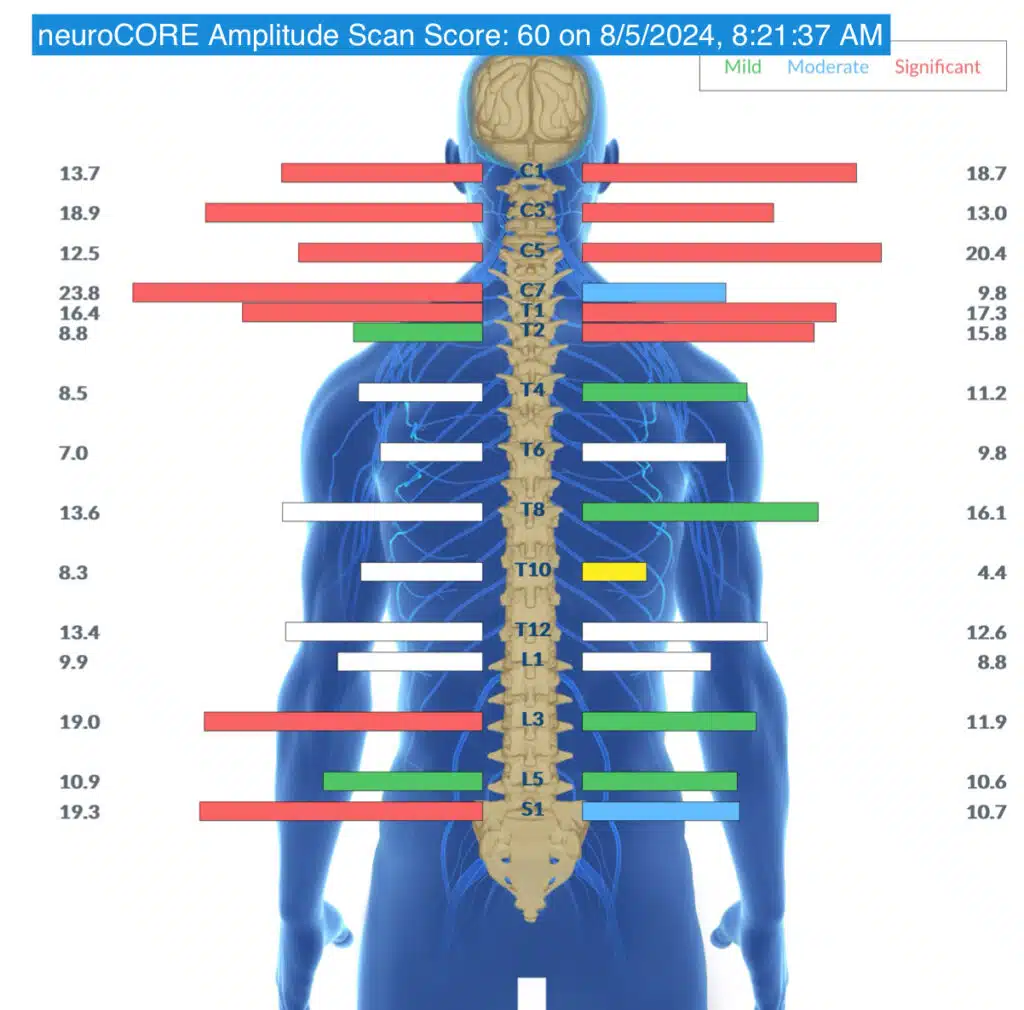There’s nothing more heart-wrenching for a parent than watching their child completely lose control—screaming, kicking, collapsing to the floor—especially when it happens in public. The stares, the judgment, and the helplessness all crash in at once. However, what many don’t understand is that these meltdowns aren’t simply behavioral problems; they’re signs of a nervous system stuck in sensory overwhelm.
For kids with autism, the world is often too loud, too bright, too fast, and too overwhelming for a nervous system already stuck in stress mode. What appears to be “bad behavior” on the outside is actually a brain and body crying out for help on the inside.
Sadly, today, far too many parents face these autism meltdowns almost daily, with now 1 in 31 children diagnosed with Autism Spectrum Disorder (ASD), who are all too familiar with the challenges of managing autism meltdowns.
Autism meltdowns are often misunderstood and can be challenging for both children and their caregivers. They are not the same as typical tantrums and require a unique approach to manage effectively. To better support children with autism and their families, it’s crucial to understand the underlying causes of meltdowns and the role of the nervous system in emotional regulation.
In this article, we’ll explore the causes, signs, and strategies for the prevention and management of autistic meltdowns. More importantly, we’ll discuss how a Neurologically Focused approach to care can help address the root cause of meltdowns and promote better outcomes for children with autism.
By gaining a deeper understanding of this complex issue, we can work together to create a more supportive and empowering environment for these exceptional children and their families.
What is an Autism Meltdown?
An autism meltdown is an intense response to an overwhelming situation. It happens when a person with autism becomes completely overwhelmed by their current environment and loses control of their behavior. During a meltdown, they may cry, scream, or lash out physically. It’s important to understand that a meltdown is not a temper tantrum, nor is it a deliberate attempt to manipulate or control a situation.
Key differences in meltdowns vs tantrums:
- Tantrums are typically a planned behavior used to achieve a specific goal or outcome, such as getting a toy or avoiding an undesired activity. Meltdowns, on the other hand, are involuntary reactions to feeling overwhelmed and are not goal-oriented.
- During a tantrum, a child maintains some degree of control over their actions. In contrast, during a meltdown, the person loses control due to the extreme emotional and physiological arousal they are experiencing.
- Tantrums usually end when the child gets what they want or realizes it isn’t working. Meltdowns often last much longer and can continue even after the initial trigger has been removed.
Meltdowns are common among children with autism, with some studies suggesting that up to 92% of children with autism experience meltdowns at some point. It’s also important to note that meltdowns can happen to individuals across the autism spectrum and are not limited to those with higher support needs. Even highly verbal adults with autism may experience meltdowns when faced with overwhelming situations.
By understanding the difference between tantrums and meltdowns, parents, caregivers, and professionals can respond more effectively and compassionately to the needs of children with autism during these challenging moments.
What Triggers Autism Meltdowns?
Meltdowns in children with autism can be caused by a variety of factors, ranging from sensory overload to emotional stress. Understanding these triggers is essential for preventing and managing meltdowns effectively.
One of the most common causes of meltdowns is sensory overload. Many individuals with autism have heightened sensitivity to sensory input, which means that even seemingly minor stimuli can be overwhelming. Some examples of sensory triggers include:
- Loud noises, such as fire alarms, school bells, or even the sound of a vacuum cleaner
- Flickering or bright lights
- Strong smells, like perfume or cleaning products
- Uncomfortable clothing or textures, such as itchy tags or rough fabric
- Crowded or chaotic environments, like a busy shopping mall or a noisy classroom
When exposed to these triggers, a child with autism may feel overloaded and unable to cope, leading to a meltdown.
The “Perfect Storm” of Factors Contributing to Autism Meltdowns
At PX Docs, we recognize that meltdowns in children with autism are not caused by a single issue but rather by a combination of factors that create a “Perfect Storm” of sensory and emotional overwhelm. This concept highlights how multiple stressors—such as sensory overload, changes in routine, and communication challenges—interact to significantly increase the likelihood of a meltdown.
In addition to the more obvious environmental or external triggers of meltdowns, the internal ones are also super important for parents of children with autism to know and understand. Children with autism struggle significantly not only with sensory overload from sounds and bright lights, but also from the following internal meltdown triggers:
- Digestive issues: When the nervous system is stuck in sympathetic dominant “fight or flight” mode and dysregulated, a child’s digestive motility and overall function is often limited significantly. When a child feels off and uncomfortable with their nervous system and digestive system on the inside, it leaves them far more sensitive to sensory overwhelm from outside stressors.
- Immune and respiratory challenges: The underlying nervous system dysregulation also leaves children with autism with a suppressed and compromised immune system and respiratory system, leaving them often feeling sick, exhausted, and unwell – which further increases their sensitivity to outside stressors.
- Sensorimotor and positional sense challenges: While not discussed nearly as often as the other sensory meltdown triggers, children with autism often experience significantly disrupted sensorimotor and proprioceptive input, tone, and coordination.
Communication difficulties also play a significant role. Many children with autism struggle to express their needs or feelings effectively, leading to frustration and escalating emotional responses. When combined with a sudden change in routine or unanticipated events, these factors can quickly compound, leaving the child feeling helpless and out of control.
It’s important to recognize that meltdowns often stem from a combination of factors, rather than a single trigger. By understanding the complex interplay of these factors, parents and caregivers can work to minimize triggers and create a more supportive environment for children with autism.
What Does an Autistic Meltdown Look Like?
Recognizing the early warning signs of an autism meltdown is crucial for parents, caregivers, and professionals working with children on the spectrum. By identifying these signs, they can intervene early and potentially prevent a meltdown from escalating.
One of the most common behavioral changes that may indicate an impending meltdown is an increase in stimming behaviors. Stimming, short for self-stimulatory behavior, refers to repetitive actions or movements that help a person with autism regulate their sensory input. Examples of stimming include:
- Rocking back and forth
- Flapping hands or flicking fingers
- Spinning or twirling objects
- Humming or repeating words or phrases
While stimming is a normal and necessary behavior for many individuals with autism, an increase in the frequency or intensity of these behaviors may signal that the child is feeling overwhelmed and is at risk of a meltdown.
Other behavioral changes to watch for include pacing, withdrawal from social interaction, covering one’s ears or eyes, and verbal outbursts such as screaming or crying. Some children may also attempt to escape from the situation, which causes them distress, a behavior known as eloping.
In addition to these behavioral signs, there may be physiological indicators of an impending meltdown. These can include:
- A flushed or red face
- Rapid breathing or hyperventilation
- Increased heart rate
- Sweating
- Trembling or shaking
- Tense muscles, especially in the jaw, shoulders, or hands
It’s important to note that every child with autism is unique, and their warning signs may vary. Some children may exhibit all of these signs, while others may show only a few. By closely observing a child’s behavior and learning to recognize their individual warning signs, parents and caregivers can respond more effectively to their needs.
When these early warning signs are noticed, it’s essential to act quickly to help the child regulate their emotions and sensory input. This may involve providing a calming, quiet space, offering sensory tools or activities, or simply offering reassurance and support. By intervening early, it may be possible to prevent an autistic meltdown from occurring or at least reduce its intensity and duration.
Strategies for Preventing Meltdowns
While it may not be possible to prevent all meltdowns, there are several strategies that parents, caregivers, and professionals can use to reduce their frequency and intensity. One of the most important strategies is identifying and minimizing triggers.
Creating a sensory-friendly environment is a key aspect of minimizing triggers. This may involve:
- Dimming lights or using soft, natural lighting
- Minimizing background noise with soundproofing or white noise machines
- Providing comfortable, soft clothing without tags or irritating seams
- Offering sensory tools like weighted blankets, noise-canceling headphones, or fidget toys
Some examples of strategies to avoid a meltdown include:
- Visual supports: These can also facilitate communication and help children with autism express their needs and feelings. For example, a child who struggles with verbal communication may be able to point to a picture or use a visual chart to indicate that they are feeling overwhelmed or need a break.
- Emotional regulation: Teaching self-regulation and coping strategies can help children with autism manage emotions and sensory input. Techniques like deep breathing, progressive muscle relaxation, and calming activities—such as listening to calming music or using a stress ball—can be beneficial. Practicing these skills during calm moments prepares children to use them effectively when they are overwhelmed.
- Consistent routines: Consistent routines and schedules are crucial for preventing meltdowns in children with autism, as they thrive on predictability. A clear daily routine helps them feel secure and less anxious. When changes are needed, prepare the child in advance with visual supports like picture schedules or social stories. Research has found that maintaining consistent routines has been linked to a 47% increase in improved social-emotional health.
While these strategies can be helpful, it’s important to recognize that they may not address the underlying neurological issues that contribute to meltdowns. This is where Neurologically-Focused Chiropractic Care can play a crucial role.
Our specialized form of chiropractic care can help promote overall nervous system balance and functioning by identifying and addressing imbalances and dysregulation, often leading to a significant decrease in parent reports of meltdowns and other sensory overload-related challenges
Managing Autism Meltdowns When They Occur
Despite our best efforts to prevent meltdowns, they may still happen from time to time. When a child with autism is experiencing a meltdown, the primary focus should be on ensuring their safety and providing a calm, supportive presence.
First and foremost, it’s crucial to make sure the child is not in danger of harming themselves or others. If necessary, gently guide them to a safe space away from any potential hazards. Remember that during a meltdown, a child may have little control over their actions, so it’s important to remain vigilant and prioritize safety.
When addressing a child during a meltdown, stay calm and avoid frustration. Use simple, clear language and speak slowly and softly. Refrain from overwhelming them with questions, and instead, offer compassion by acknowledging their feelings without judgment. Use phrases like “I see you’re upset” and reassure them that they are safe and the meltdown will pass.
Every child with autism is unique, and what works to calm one child may not work for another. Some children may find comfort in deep pressure, like a tight hug or being wrapped in a weighted blanket. Others may prefer to be left alone in a quiet, dimly lit room. Some may benefit from sensory tools like noise-canceling headphones or a favorite fidget toy.
An individualized plan for managing meltdowns is crucial, tailored to the child’s specific needs and developed with parents, caregivers, and healthcare professionals. Regularly review and update the plan as the child grows and develops. After a meltdown, give the child time and space to recover, as they may feel exhausted or confused. Offer gentle support without delving into details, and focus on helping them regain calm and emotional regulation.
The Neurological Foundation of Autism Meltdowns
To effectively support children with autism and reduce the frequency and intensity of meltdowns, it’s essential to understand the underlying neurological factors that contribute to these episodes. One of the key players in emotional regulation and sensory processing is the Autonomic Nervous System (ANS).
The ANS has two main branches: the sympathetic nervous system, which activates the “fight or flight” response, and the parasympathetic nervous system, which promotes “rest, regulate, and digest” functions. In children with autism, there is often an imbalance between these two branches, with an overactive sympathetic response and an underactive parasympathetic response. This imbalance, known as dysautonomia, can make it difficult for children to regulate their emotions and respond appropriately to sensory input.
Another important factor in the neurological basis of autistic meltdowns is subluxation, which alters and distorts sensorimotor and proprioceptive input into the brain and nervous system. When subluxation is present, it can contribute to a state of heightened sympathetic stress and reactivity, making it more difficult for children to cope with challenging situations. In addition, subluxation in specific regions of the neurospinal system can interfere with the vagus nerve and parasympathetic nervous system, which are essential components of the nervous system that a child needs to be able to access and activate during stressful and overwhelming situations.
The vagus nerve, which plays a crucial role in regulating the parasympathetic nervous system, is also often implicated in autistic meltdowns. Dysfunction of the vagus nerve can lead to Sensory Processing Disorder, difficulties with emotional regulation, and impaired social engagement.
By addressing these underlying neurological imbalances, it may be possible to reduce the frequency and intensity of meltdowns and improve the overall quality of life for children with autism.
The PX Docs Approach to Supporting Children with Autism
At PX Docs, we recognize the complex neurological factors that contribute to autistic meltdowns and other challenges faced by children on the spectrum. Our approach is centered around identifying and addressing nervous system dysregulation through Neurologically-Focused Chiropractic Care.
One of the key tools we utilize in our practice is the INSiGHT scanning technology, which enables us to objectively assess the function of a child’s nervous system and pinpoint areas of subluxation and dysregulation. By gathering this detailed information, we can create customized care plans that target the specific needs of each individual child.
This EMG scan, for example, shows a common pattern we see in children who struggle with major meltdowns: areas of overwhelming sympathetic “stress” activity (red), alongside layers of deep exhaustion from years of subluxation and nervous system dysregulation (yellow).

In addition to our Neurologically-Focused Chiropractic Care, we also prioritize patient education and empowering families with the knowledge and resources they need to support their child’s development. We recognize that a child’s success depends not only on the care they receive in our office but also on the support and understanding they have at home and in their community.
To this end, we work closely with parents, caregivers, and other healthcare professionals to ensure a collaborative and holistic approach to care. We believe that by working together and addressing the root causes of autism challenges, we can help children with autism thrive and reach their full potential.
Supporting Your Child’s Neurological Health and Well-being
Autism meltdowns can be challenging for both children and their families, but by understanding the underlying causes and implementing effective strategies for prevention and management, it is possible to reduce their frequency and intensity.
Remember that every child with autism is unique, and what works for one may not work for another. It’s essential to approach meltdowns with compassion, patience, and a willingness to adapt to your child’s individual needs.
By creating a supportive environment, teaching self-regulation skills, and seeking out Neurologically-Focused Care when needed, you can help your child build resilience and thrive in the face of challenges.
If you suspect that your child’s meltdowns may be related to underlying neurological imbalances, we invite you to visit our PX Docs directory and find a chiropractor near you. With the right support and interventions, your child can develop the tools and skills necessary to manage their emotions, navigate sensory challenges, and build positive relationships with the world around them.
Together, we can help your child navigate the challenges of autism and build a foundation for a happy, healthy, and fulfilling life!



![[GRID] Calming the Sensory Storm WEBINAR PX Docs Webinar](https://pxdocs.com/wp-content/uploads/2025/11/GRID-Calming-the-Sensory-Storm-WEBINAR.png.webp)


